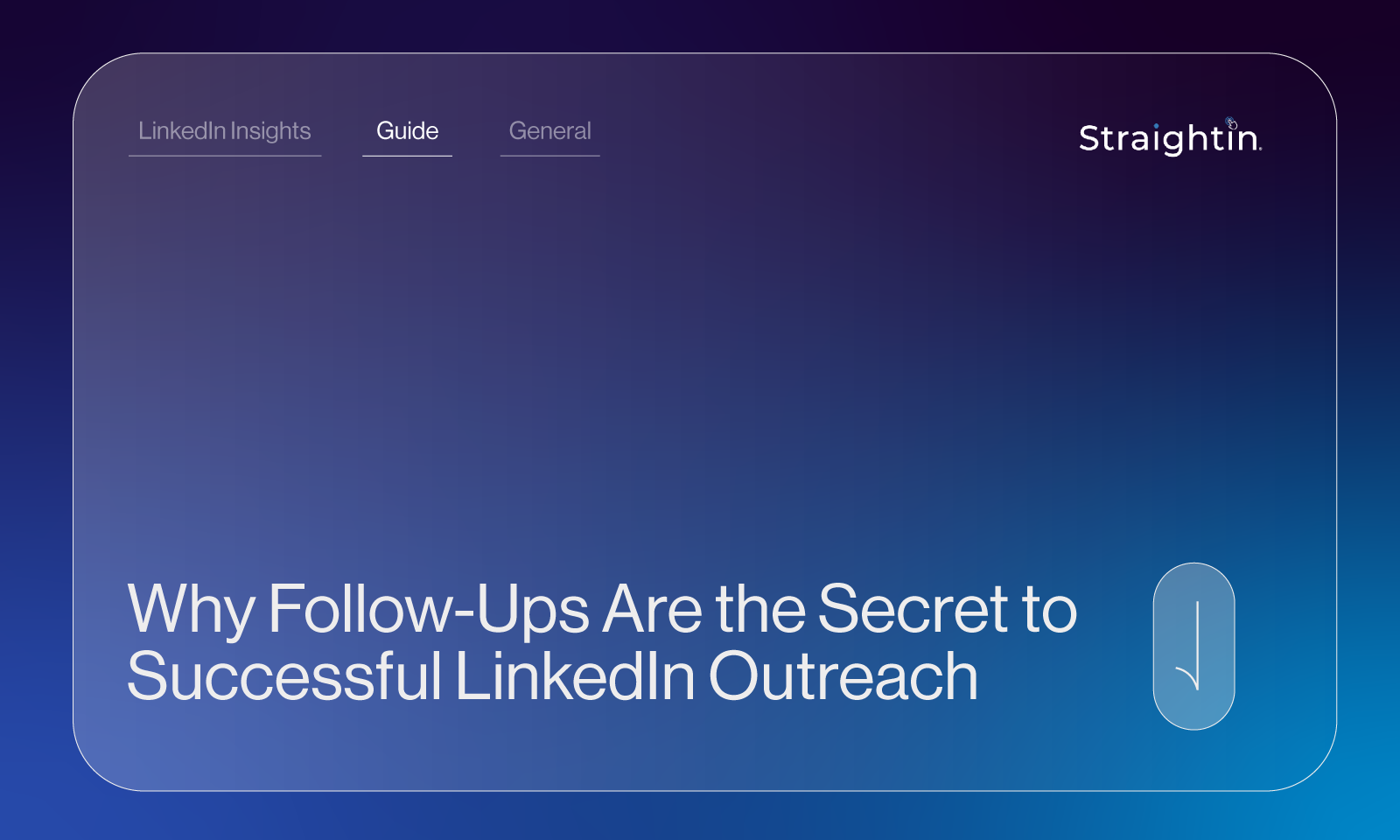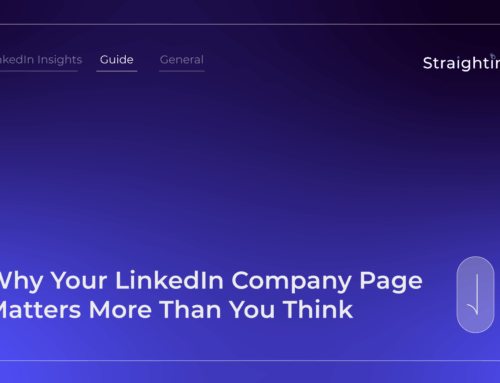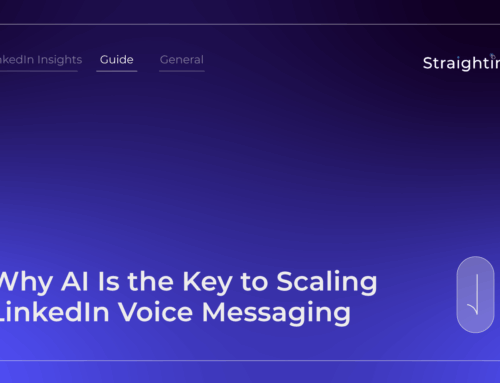When it comes to LinkedIn outreach, the first message is just the starting point. The real difference lies in the follow-up. Too many businesses treat outreach as a one-and-done exercise, firing off a connection request or a quick note and moving on.
The reality is that success in LinkedIn lead generation rarely comes from a single touchpoint. It comes from persistence, timing, and building familiarity through consistent engagement.
Shockingly, nearly half of all salespeople (48%) never make any follow-up attempts. That means a huge number of opportunities are lost, not because the offer wasn’t relevant, but because the conversation was never nurtured. In the world of LinkedIn messages, following up is what transforms a cold connection into a warm conversation.
At StraightIn, we see this every single month in the results we deliver for our clients.
What Two Months of LinkedIn Outreach Tell Us About Follow-Ups
August and September are often unpredictable months for outreach. With holidays, shifting schedules, and decision-makers in and out of office, it’s easy for momentum to dip. But our recent results prove that consistency in follow-up activity is what keeps opportunities flowing, even during quieter periods.
In August, our team completed 81,502 follow-ups, generating 2,072 qualified opportunities in total—1,136 by phone and 936 by email. Each “opportunity” represents a qualified lead: a prospect who engaged in a meaningful way and showed interest in continuing the conversation.
Phone opportunities led to booked calls or virtual meetings, while email opportunities involved meaningful replies that opened dialogue and moved prospects closer to a potential meeting.
It was a month marked by steady effort and strong conversion, demonstrating how persistence and structure can cut through the typical summer slowdown. Even with many prospects away or distracted, consistent and thoughtful follow-up made sure our clients stayed visible and top of mind.
Then came September. As activity increased to 97,157 follow-ups, opportunities also climbed to 2,452, including 1,294 by phone and 1,158 by email. That’s an uplift across every metric, showing that even modest increases in consistent, structured outreach translate into measurable growth.
When teams consistently deliver timely, well-crafted follow-ups, they maintain momentum and strengthen relationships with prospects who may not be ready to engage immediately.
Across the two months, our team delivered over 178,000 follow-ups and more than 4,500 qualified opportunities, reinforcing a simple truth: consistent follow-up is the engine that powers successful LinkedIn outreach. Whatever the season or circumstances, maintaining regular, thoughtful follow-up is what transforms first contact into meaningful conversations and tangible results.
Why Follow-Ups Are So Important in LinkedIn Lead Generation
The takeaway? Success in LinkedIn outreach isn’t about firing off one message and crossing your fingers. Buyers are busy, inboxes are crowded, and in B2B especially, decisions don’t happen overnight.
In fact, according to the State of Virtual Selling report:
- 40% of sales professionals have seen a rise in the number of stakeholders involved in a single deal
- Nearly 25% are now selling to five or more decision-makers
- Over half are dealing with two to four stakeholders per opportunity
In practice, this means more people to persuade, more silent research happening behind the scenes, and more prospects Googling your name, your company, and your track record before they even consider replying to your message.
That’s why you need to keep following up so that you are always at the top of mind. It keeps you visible, credible, and in the running when the buying decision finally comes together.
Our Head of Operations, Shannon Townsend, who has overseen thousands of campaigns during her time at StraightIn, puts it best:
“Outreach without follow-ups is like going to the gym once and expecting a six-pack. It’s the consistent reps that build results, not the one-off effort. Of course, it can feel demoralising when the replies don’t come straight away, but that’s why mindset matters. Stay positive, keep showing up, and the results will come.”
How to Follow Up Effectively with LinkedIn Outreach
Following up is as much an art as it is a numbers game. The goal isn’t just to send more LinkedIn messages, but to make each one count. Done right, follow-ups keep you on a prospect’s radar without crossing the line into spam and, let’s face it, being annoying.
Here are some proven tips to help your outreach stand out while building trust over time:
1. Space out your messages thoughtfully
Timing is everything in follow-ups. Bombarding someone with five messages in five days won’t do you any favours. It risks irritating your prospect and makes you look impatient. Instead, think of follow-up as a steady rhythm rather than a rapid-fire campaign.
Start with a short gap of two to three days after your initial message to catch their attention while the first outreach is still fresh in their mind. After that, gradually increase the spacing, perhaps a week for the next touchpoint, then ten days for the one after that. This steady approach shows persistence without pressure and respects the prospect’s time.
The truth is that people are busy. Even if they’re interested, replying to your message might not be at the top of their to-do list. By giving them space, you’re making it easier for them to engage with you on their terms. The goal is to remain present and professional without crossing the line into being pushy.
2. Add value with every touchpoint
The quickest way to be ignored in a follow-up is to say, “Just checking in.” It doesn’t give the prospect any reason to reply. A strong follow-up, on the other hand, gives them something meaningful. That could be a quick industry insight, a link to a relevant article, or a thoughtful question that shows you’ve taken the time to understand their role and challenges.
If your messages consistently offer something useful, you stop being “another salesperson” and start becoming a trusted voice. Adding value doesn’t always mean sending long reports or detailed whitepapers. Sometimes it’s as simple as referencing a trend in their industry, pointing them toward a resource, or offering a practical idea they can put to use. The key is that every interaction feels purposeful, not like a reminder that you’re still waiting for a reply.
When prospects feel they’re getting something out of the exchange, they’re more likely to keep the conversation going.
3. Keep it concise and human
If someone didn’t reply to your first message, chances are it was too long. Nobody opens LinkedIn hoping to wade through a wall of text. Lengthy, formal messages are often skimmed at best or ignored altogether. The best follow-ups are short, clear, and easy to digest at a glance.
Write as if you’re starting a quick conversation, not submitting a report. A few sentences that get to the point are far more effective than several paragraphs of sales talk. Being conversational also makes you feel approachable. A message that sounds like it was written by a real person naturally invites a real response.
Equally important is tone. People are far more likely to reply to someone who sounds human than to a templated pitch that looks like it’s been copied and pasted to a hundred others. By keeping it natural, you show that you value the prospect’s time and that you’re genuinely interested in engaging with them, not just chasing numbers.
4. Avoid ChatGPT
Following on from the point above, prospects can quickly spot when a message feels like it’s been churned out by a machine. Overly polished sentences, repetitive structures, or generic wording are dead giveaways that your follow-ups aren’t genuine. If your messages read like a mass-produced script or an AI-generated template, they’ll struggle to spark real engagement.
The most effective follow-ups sound like they come from you. Keep them natural, conversational, and consistent with the way you’d speak if you were on a call. Use your own phrasing, keep the tone professional but approachable, and don’t be afraid to let some personality show through. If you are funny and self-deprecating, be funny and self-deprecating. If you are thoughtful and analytical, be thoughtful and analytical.
People want to connect with people, not bots, not templates, not faceless automation. A follow-up that feels human immediately sets you apart in a world where too many inboxes are flooded with copy-paste pitches.
5. Keep your content marketing up to date
Follow-ups don’t exist in a vacuum. When a prospect receives your message, one of the first things they’ll do is click through to your LinkedIn profile or your company page. It’s part of the decision-making process: they want to see who you are, what you stand for, and whether you are worth their time.
If your last post was months ago or if there’s nothing there at all, it sends the wrong signal. An inactive profile can make even the best outreach message feel less trustworthy. On the other hand, a profile backed by regular updates shows that you’re engaged in your industry and actively contributing to conversations that matter.
This is where content marketing comes in. Sharing useful updates, thought leadership posts, industry insights, or proof of client success gives your prospects a reason to take you seriously. It reassures them that you’re not only active, but also knowledgeable and reliable.
Your messages spark the conversation, but your content reinforces why you’re worth speaking to. When prospects do their research (and trust us, they will), they should find a business that looks alive, relevant, and worth engaging with.
6. Know when to hit pause
Following up is important, but so is knowing when to step back. Persistence opens doors, but too much pressure can slam them shut. If you’ve already sent several messages and haven’t had a single response, it’s a signal to ease off.
Silence doesn’t always mean “never” (at least not always), it often just means “not now.” Prospects might be too busy, dealing with internal priorities, or simply not ready to engage. By parking the lead and revisiting it later, you give them time and space while keeping your reputation intact.
A respectful pause also protects the relationship for the future. Push too hard and you risk being remembered as the person who wouldn’t stop messaging. Step back gracefully, and you leave the door open for re-engagement when the timing is better.
Follow-up is a long game. Sometimes the best move isn’t another message today. It’s patience and a well-timed approach down the line.
LinkedIn Outreach That Builds Pipelines, Not Just Connections
The numbers tell the story. In just six weeks, our team made over 100,000 follow-ups and generated 2,837 opportunities for our clients.
If there’s one takeaway from this article, it’s this: opportunities aren’t created by volume alone. They’re created by persistence.
Every follow-up is a chance to stay visible, build credibility, and move a prospect closer to a real conversation. It’s the difference between a connection that fizzles out and a pipeline that delivers measurable results.
Our approach to LinkedIn lead generation is built on that principle. We don’t stop at making connections. We keep the conversation going—consistently, professionally, and humanly—until it turns into something meaningful. Follow-ups shouldn’t be treated as an afterthought. They’re the point where outreach turns into growth.
At StraightIn, we know that successful LinkedIn outreach doesn’t end with the first message. It’s the follow-ups that build pipelines and create real opportunities. That’s why we specialise in Outreach Marketing, LinkedIn Advertising, Content Marketing, and Personal Branding, helping businesses like yours cut through the noise and connect with the people who matter most.
If you’re ready to turn more connections into conversations and more conversations into clients, get in touch with us today. Call 0161 518 4740 or email grow@straight-in.co.uk to find out how we can help your business grow.







